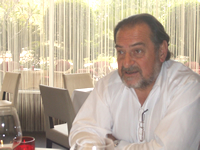Michel Rolland, the indefatigable consultant Bordelais winemaker on his annual visit to Grover Vineyards in Bangalore was taking a brief stopover in Delhi last week for the official release of the Art Series labels at the French Ambassador’s residence when Subhash Arora met him for a quick chat and tasted a few of the wines from his Rolland Collection, soon to debut in India .
Many critics may argue that with over a 100 estates he consults with globally as a winemaker, Michel can hardly give the proper attention that is required in the area of viticulture as well as winemaking and many estates engage him for his name as the brand. Many Bordeaux producers criticise him for having crossed over to the opposition - the New World, by encouraging overripe, powerful and bold wines.
But Michel takes the criticism in his stride. ‘Bordeaux producers unfortunately believe that to excel you have to beat your neighbour, rather than focussing on your own excellence,’ he says. Obviously, he is so focussed on his long time client Grover Vineyards that he has not had a chance to look at the Maharashtra wine industry-he might feel at home there.
He is as proud to be a Bordeaux producer as his neighbour or any one else-he owns several small family estates like Ch. Le Bon Pasteur in Pomerol, Ch. Rolland Maillet in St. Emilion and Ch. Fontenil in Saillans. ‘It is just that I have been always been active and pro-active in adopting new techniques to improve the quality of grapes which is fundamental to making good wines.’
Claiming to have been one of the first to start green harvesting, removing leaves, sorting vineyards for multi-day harvesting, over 20 years ago he said, ‘today, many Bordeaux producers would tell you that they have been following the procedure for decades. They may also insist the practice has been followed historically for a much longer period-which is not correct.’
Talking about moving away from the classic Bordeaux style into over-ripe, full blown, powerful wines he said. ‘I am an advocate for full polyphenolic ripening of grapes which is not necessarily linked with higher brix levels which yield only higher alcohol. Although there are issues like proper pH, acidity and Brix levels that have to be addressed, proper polyphonic ripening of grapes is the key issue for me. Naturally, the wines turn out more concentrated and with fuller flavours on the palate. '
Michel also seems to favour oak aging his red wines for 12-18 months in French barriques, generally varying from 50-80% new oak, whether he produces wine in France, Chile, Argentina or South Africa. This helps him get the complexity, mellowness and ageability, he feels.
Direction of Bordeaux
 He admits that Bordeaux has had problems during the last 10-15 years in selling wines ‘because of the entry of New World wines like Chile and more specifically Australia who could afford to under-price them. But the problem is that for centuries they have been used to concentrating on production only. Selling was never a problem. People came asking for the wines even if they were not much written about. Now things have changed and marketing efforts are required for which they are not trained. But the people in the area are not stupid; they have already pinpointed the problem and are working towards marketing themselves better.’ He admits that Bordeaux has had problems during the last 10-15 years in selling wines ‘because of the entry of New World wines like Chile and more specifically Australia who could afford to under-price them. But the problem is that for centuries they have been used to concentrating on production only. Selling was never a problem. People came asking for the wines even if they were not much written about. Now things have changed and marketing efforts are required for which they are not trained. But the people in the area are not stupid; they have already pinpointed the problem and are working towards marketing themselves better.’
En Primeur 2008
‘The En Primeur 2008 is a good example of the change. Many of the First Growths have dropped their prices by up to 50%, even if they are not selling too much quantity at these low prices.’ Incidentally, Michel is very upbeat on the vintage. The summer rains troubled us but the late September and early October sun helped us wait for the harvest much longer; we harvested around 10th October by which time we normally finish it. The yield has of course been lower but this could be a blessing in disguise as it will help deplete some of the over stocks.’
Implicit in his talk was the fact that it may be exciting to buy at the current low prices, adding ‘the trouble is the consumer does not get those low prices- the negociants add their mark ups and one may not always get good prices for all the wines.
Another logical reason he advances for a better future for the Bordeaux wines is that ‘people throughout the world are getting tired of high alcohol wines coming from the New World. They don’t want the 14.5% to 15.5% wines. Bordeaux offers wines naturally produced at 12.5-13%; therefore, many consumers are returning to the low alcohol Bordeaux.
(DelWine has been actively campaigning against wines with more than 14% alcohol, notwithstanding the fact that wines with a good balance and harmony may carry the higher alcohol, the liver and heart may not-unless the equivalent amount is reduced from the intake)
Incidentally, he feels that Bordeaux is not threatened by California wines. ‘Although they produce some good quality wines, their prices are too high and the quantity is also not large enough-it gets consumed within the country,’ he adds.
The rumours about Chateau Latour being on the block keep on surfacing. Even today an article in just-drinks.com referred to it. What about the rumours that one of his clients, the billionaire Bernard Magrez has been on the forefront of potential buyers, I ask.
‘As you know I consult with his Pape Clemont estate. It’s true that Bernard would love to acquire a top-level property in Bordeaux and there were talks between him and the owners of Latour last November. But as far as I know, Chateau Latour has decided against selling and Mr. Magrez is looking at some other properties. I think the chapter of the Latour sale stands closed as of now,’ he says with a chuckle.
Tasting the Rolland Collection
 When in India this time, Michel wore two hats. Apart from looking at the Grover vines and wines, he is also promoting wines from wineries throughout the world, where he is a part or family owner. He picks out wines produced by the family-partnered estates or blended by him and rolls out a portfolio of ‘The Rolland Collection’. I had an opportunity of tasting five red wines from this Collection at the Rick’s bar at the Taj Mahal Hotel, hours after I had landed from Spain. When in India this time, Michel wore two hats. Apart from looking at the Grover vines and wines, he is also promoting wines from wineries throughout the world, where he is a part or family owner. He picks out wines produced by the family-partnered estates or blended by him and rolls out a portfolio of ‘The Rolland Collection’. I had an opportunity of tasting five red wines from this Collection at the Rick’s bar at the Taj Mahal Hotel, hours after I had landed from Spain.
Bon Pasteur Pomerol 2004 Ch. De Bon Pasteur ($90)
A blend of 80% Merlot and 20% Cabernet Franc, the classical right bank blend, the wine shows his signature, with soft and juicy tannins coating your palate with berries and dancing even on the back palate leaves a persistent trail. A well-balanced and harmonious wine, that.
Rolland Maille St. Emilion Grand Cru 2005 Ch. Rolland Maille ($49)
The family owned vineyard also uses about 80% Merlot. The hot and well regarded vintage, it is still not fully ready to drink and will age well for the next 5-15 years, but will be ready-to-drink sooner. Due to the hot weather alcohol level has gone up slightly higher, to 14% but the balance makes it a delicious wine with a complex, fruity flavour.
Bonne Nouvelle Stellenbosch 2004 ($45)
Made in the Simonsberg area in Stellenbosch in a small estate owned with Boustred & Co. it is a Bordeaux blend compromised with 6% of Pinotage, added to 60% Merlot and 32% Cabernet Sauvignon, one can feel a bit of sweetness due to oak vanilla. Full on the palate, it is a powerful, long and complex wine with berries exploding on the palate.
Val de Flores Mendoza 2004 ($65)
The best expression of Malbec from a cool Mendoza region, where the vineyards are at a 1000 m altitude, it is a rather elegant, full bodied, almost inky coloured wine that would take nothing less than a serious red meat dish.
Yacochuya Cafayate 2003 ($50)
Another example of what a fine Malbec a cool clime vineyard makes in Argentina; these being at 2000m altitude. Slightly more powerful than Flores, another full bodied, dark inky powerful wine that despite its fine balance tasted like 15% alcohol.
All these wines have gone through 12-18 months oak-only French, as one can expect from Michel. Very rounded and fairly expensive wines, all. (Prices given are average retail prices sourced from www.wine-searcher.com).
 Brindco has started importing the Rolland Collection. Decidedly, the Rolland Maille tasted the best value-for-money wine. Since wines are hardly aged at the importers end or at the restaurants, this wine is most ready to drink and show its charm. One can see his personality and what he has done for the wine quality. Argentinean wines in that price range may find few takers, even when imported duty-free by the hotels. Brindco has started importing the Rolland Collection. Decidedly, the Rolland Maille tasted the best value-for-money wine. Since wines are hardly aged at the importers end or at the restaurants, this wine is most ready to drink and show its charm. One can see his personality and what he has done for the wine quality. Argentinean wines in that price range may find few takers, even when imported duty-free by the hotels.
One is sure to find the Rolland Collection in the premium section of wine menus of many restaurants soon. It would be interesting to watch how the consumers react to these expensive tasting wines at expensive prices. Check out the Grand Cru Rolland Maille from St. Emilion where available.
And remember, when you order a bottle of Grover wine, you can be reasonably sure that the same Rolland Collection winemaking philosophy has gone into it.
Subhash Arora
|